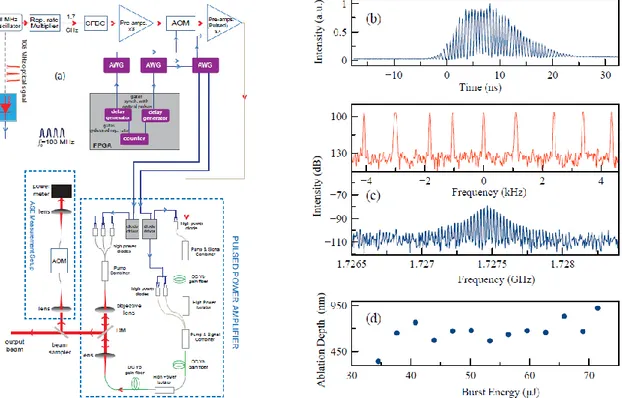1.7-GHz Intra-burst Repetition Rate Yb-Fiber Amplifier System
H. Kalaycıoğlu1, P. Elahi1, C. Kerse², Ö. Akçaalan1, D. K. Kesim², F. Ö. Ilday 1,2 1. Department of Physics, Bilkent University, TR-06800, Ankara, Turkey
2. Department of Electrical and Electronics Engineering, Bilkent University, TR-06800, Ankara, Turkey
Material processing efficiency of ultrafast pulses increases dramatically with repetition rate of the pulses, if the conditions are adjusted correctly to avoid excessive plasma and particulate shielding. However, given that there is a minimum pulse energy requirement, continuous operation at high repetition rates can be detrimental due to too much average power leading to heat accumulation. Burst-mode operation of lasers, wherein the amplifier periodically produces a group of pulses (a burst), which are very closely spaced in time, avoids this problem. However, ultrafast burst-mode lasers are typically limited to several 100 MHz intra-burst repetition rates. While this is sufficient for most materials, metals with high thermal conductivity require higher repetition rates.
Here, we demonstrate an all-fiber Yb burst mode laser amplifier system with an in-burst repetition rate of 1.7 GHz, which is optimized for low burst repetition rate. The system is able to produce 20-ns long bursts with a total energy of 175 J at a burst repetition rate of 1 kHz, and the individual pulses are compressed down to the sub-picosecond level. The seed signal from a 108 MHz fiber oscillator is converted to 1.7 GHz by a multiplier consisting of eight cascaded 50/50 couplers, and then amplified in nine stages (Fig. 1(a)). The highly cascaded amplification aims to suppress ASE at the low repetition rate. Pulsed pumping synchronized with the seed by an FPGA-based electronic system is employed in the six latter amplifier stages. Pump pulses are optimized to obtain the highest signal-to-ASE ratio, while ASE is monitored closely at the output of the system. At 1 kHz burst repetition rate 235 mW is obtained with 25% ASE for bursts of 20 ns duration, indicating a net burst energy of 175 J. The amplified bursts (Fig. 1(b)) contain about 35 pulses of 5 J average and 8 J maximum individual energy. The RF spectra of the output shows a comb with a main lobe centered near the in-burst frequency of 1.73 GHz (lower part of Fig 1(c)), with the close-up in this lobe revealing the harmonics of the burst repetition frequency of 1 kHz (upper part of Fig. 1(c)). Previously, we have observed significant increases of efficiency with in-burst rates of 100 and 500 MHz compared to the uniform repetition rate [1]. Fig. 1(d) demonstrates preliminary ablation results for in-burst repetition rates of 1.7 GHz, and 20 ns long bursts repeated at 1 kHz. We will continue our investigations at the in-burst rates of 864 MHz, 432 MHz, 216 MHz and 108 MHz, thus systematically investigating a previously unexplored regime of ultrafast laser-material processing.
Fig. 1 (a) Functional diagram of the system. (b) Temporal profile of amplified bursts of 175 µJ. (c) RF spectrum of the output. Lower part is a span of 3 MHz centred near 1.73 GHz, and upper part is a close-up of the lobe with a span of 10 KHz. (d) Preliminary ablation results on copper showing ablation depth per burst versus burst energy.
[1] C. Kerse, H. Kalaycıoğlu, F. Ö. Ilday, E. Atalar, “Non-thermal Material and Tissue Processing with 100 MHz and 500 MHz Repetition Rate Bursts,” CLEO Europe-OSA Technical Digest (2013).
